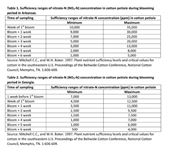Louisiana Cotton: Petiole Sampling For In-Season Nitrogen Management
DR. RASEL PARVEJ, DR. BRENDA TUBANA AND DR. SYAM DODIA
BATON ROUGE, LA.
Cotton in-season nitrogen (N) status can easily be tracked by different methods such as crop sensing (vegetation indices), measurement of leaf chlorophyll content, and petiole (leaf stalk that connects the leaf blade to the main-stem) testing for nitrate-N (NO3-N) concentration. Monitoring petiole nitrate-N concentration is the best tool of tracking in-season N status in cotton. This tool allows producers and crop consultants to predict the yield potentials dictated by soil nutrition and environmental conditions and adjust in- season N supply, if needed, to help achieve the highest potential yield. In addition, it helps motivate producers not to apply excessive amount of N at planting and hope for the best, which often causes environmental concerns. Also, excessive N results in continuous vegetative plant growth that delays maturity, increases pest problems, and decreases harvest-aid effectiveness. Cotton petiole nitrate-N concentration typically indicates in-season N need 7-10 days prior to the onset of N deficiency stress.
A successful petiole nitrate-N monitoring program consists of several weekly petiole samplings starting at one week prior to first bloom and continue for 4 to 5 weeks after first bloom. At each sampling time, at least 20 uppermost recently mature leaves with petioles on the vegetative stem should be collected. These leaves are usually the 3rd to 5th leaf from the terminal (a quarter-sized main-stem leaf at the top of the plant should be counted as the 1st leaf). The petiole of each sampled leaf should be separated from the leaf blade, placed in a labeled paper bag, and sent immediately to the plant diagnostic lab for nitrate-N, total phosphorus (P), and total potassium (K) concentrations. The total N concentration in leaf blade at first bloom is also important in interpreting petiole nitrate-N concentration.
Therefore, the leaf blade (without petiole) of the collected sample at first bloom should also be analyzed separately for total N concentration. Leaf blade testing is not required at other sampling times. The K concentration in the petiole is also valuable in monitoring in-season K nutritional stress since K is one of the key nutrients in cotton production.
Cotton petiole nitrate-N concentration across the blooming period can be interpreted using the nitrate-N concentration in Table 1 and 2.
Table 1 consists of Arkansas interpretations and Table 2 consists of Georgia interpretations. The Arkansas interpretation offers higher sufficiency ranges of nitrate-N concentration than the Georgia interpretation and should be used for cotton production in Louisiana.
Petiole nitrate-N concentration in both interpretations peaks before blooming and then gradually declines towards boll maturation. In the Arkansas interpretation (Table 1), the sufficient petiole nitrate-N concentration ranges from 10,000 to 35,000 ppm (1 to 3.5%) at first bloom and 1,000 to 5,000 ppm (0.1 to 0.5%) 6-wk after first bloom and the sufficient leaf blade N concentration ranges from 3 to 4.5% N at first bloom stage. It is very important to note that these sufficiency ranges of petiole nitrate-N concentration across the blooming stages are not the critical levels, but desirable ranges, and nitrate-N concentrations below or above these desirable ranges do not directly indicate N deficiency or sufficiency because petiole nitrate-N concentration is greatly influenced by plant stress caused by several abiotic and biotic factors. However, these sufficiency ranges may indicate in-season N status and incipient problems. Along with nitrate- N concentration, P concentration in petiole during the blooming period is very important in understanding environmental or physiological stress that can influence petiole nitrate-N concentration and hence the interpretation. For example, petiole P concentration at first bloom should be >800 ppm (>0.08%) and a decrease of >300 ppm (>0.03%) petiole P concentration from the previous week during blooming period is a good indicator of water stress and in-season N fertilization decision should be delayed until the next sampling results are received. For proper interpretation of petiole nitrate-N concentration, it is very important to make sure that the observed petiole nitrate-N concentrations have not been influenced by any stress during the growing season. Therefore, petiole nitrate-N concentration should be interpreted and in-season N fertilization decision should be made based on physiological, environmental, and nutritional conditions including crop growth stage, soil moisture status, irrigation events, seasonal rainfall amount, fertilization history, leaf blade N concentration at first bloom, petiole P concentration trend during blooming period, fruiting load, internode length, number of nodes above the white flower, pest damage, heat units, cloud cover, etc.
Overall, monitoring in-season petiole nitrate-N concentration is simply a tool that, in combination with other stress indicators, can help make better in-season N management decisions and maximize cotton yield and profitability. This tool is best suited for high yielding cotton fields with irrigation or in high rainfall areas where water does not limit yield. Care should be taken in making in-season N fertilization decisions for fields with a potential for late-season N mineralization from organic materials. ∆
DR. RASEL PARVEJ, DR. BRENDA TUBANA, AND DR. SYAM DODIA: LSU AgCenter Soil Scientists
